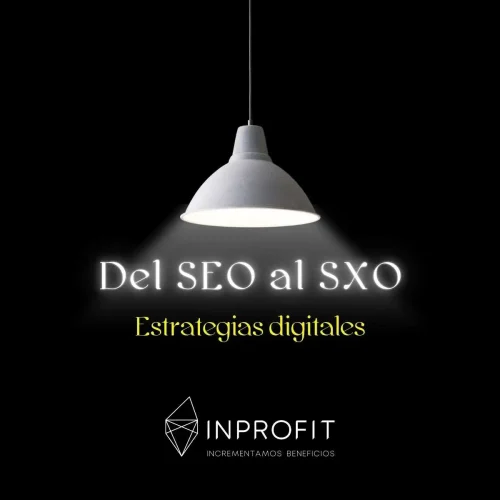This is where SXO (Search Experience Optimization) comes in, an evolution that combines SEO best practices with a clear focus on user experience.
This change is not just a fad; it reflects the way in which search engines, led by Google, are prioritizing user experience as a key factor for positioning. If SEO was focused on attracting traffic, SXO is looking for something more: converting that traffic into customers, satisfied users or loyal followers.
From SEO to SXO: What is this change?
SXO goes beyond optimizing pages for keywords or building links. Its essence lies in improving the overall user experience, from the moment they search for information to the moment they take an action within your website. This includes elements such as loading speed, intuitive design, content quality and ease of completing tasks such as making a purchase or filling out a form.
For example, it is not enough for an e-commerce to appear at the top of Google if its page takes 10 seconds to load or if its checkout process is confusing. SXO demands that every touch point with the user be designed to meet their needs quickly and efficiently.
Pillars of SXO: The new digital strategy
Relevant content of value
Content is still king, but now it is expected not only to inform, but also to answer users’ questions accurately. In addition, it must be structured for easy reading on any device.
Example: a blog about recipes could include not only the traditional text, but also video tutorials, downloadable ingredient tables and direct links to buy utensils.
2. User-centered design (UX)
The design of a website is crucial for SXO. Users must be able to navigate the site effortlessly, find what they are looking for in seconds and complete actions without friction.
Key elements include:
- Responsive design: Optimization for mobile devices.
- Intuitive navigation: Clear menus and well-defined access paths.
- Call to Actions (CTAs): Buttons and links that guide the user to conversion.
3. Loading speed
Google has made it clear that loading speed is a determining factor for ranking. According to studies, a one-second delay in loading can reduce conversions by 7%. Tools such as Google PageSpeed Insights help identify areas for improvement.
4. Optimization for search intent
SXO focuses on understanding what the user really wants when they search. Are they looking for information? Do they want to buy something? Are they comparing options? Pages should be designed to satisfy these intentions.
Example: an online store that sells bicycles should have specific sections for “buying guides”, “comparisons” and “direct purchases”.
5. Post-Click Experience
The job doesn’t end when the user clicks on your page. This is where the true user experience comes into play. Fast pages, visually appealing content and easy processes are critical to success.
Why is SXO the future of Digital Marketing?
The shift to SXO is not arbitrary; it responds to a reality: the user is more demanding and has more choices than ever before. Google, as the leading search engine, is also evolving to meet these expectations. Updates such as Core Web Vitals and Page Experience are a clear sign that user experience is now a priority.
Moreover, SXO not only benefits users. Companies that implement this strategy achieve:
- Increase conversions: Satisfied users are more likely to take action.
- Reduce bounce rate: A pleasant experience keeps visitors on your site longer.
- Build trust: Well-designed and functional pages build credibility.
Success stories
1. Amazon
Amazon has been a pioneer in integrating SXO into its strategy. Every detail of its platform is designed to optimize the user experience, from the product search to the checkout process. Loading speed, personalized recommendations and ease of use are clear examples of how SXO can translate into sales.
2. Spotify
Spotify has optimized its user experience not only in terms of design, but also in personalization. Its algorithm recommends playlists based on user tastes, improving user satisfaction and loyalty.
3. Airbnb
Airbnb has implemented an intuitive design and simple navigation that allows users to find and book accommodations quickly. In addition, its focus on engaging visual content (high quality photos and detailed descriptions) is a clear example of SXO in action.
How to implement SXO in your strategy?
Search Experience Optimization is an approach that combines SEO and UX to ensure that you not only attract users to your website, but also provide them with a smooth and satisfying experience. To begin with, it is crucial to understand that SXO focuses on both search engine optimization and user experience on the site. This approach goes beyond keywords and algorithms, seeking to understand and satisfy users’ needs.
The first step in implementing SXO is to conduct thorough keyword research, prioritizing the search intent behind each term. This means identifying whether users are searching for information, comparing options or ready to convert. Tailoring content according to this intent improves relevance and visitor engagement. In addition, optimizing on-page content is essential. This includes using titles and descriptions that are clear and appealing, structuring content with well-defined headings, and offering visual resources such as images, videos and graphics that make the experience more dynamic and interesting.
A crucial aspect of SXO is to ensure an exceptional user experience on your website. This involves working on loading speed, responsive design that adapts to different devices and implementing elements that guide the user, such as clear call-to-action buttons. For example, if a user arrives looking for a specific product, facilitating the path to purchase with an intuitive and frictionless navigation will increase the chances of conversion. Integrating structured data such as FAQs or ratings into search results can also improve the user’s initial experience with your site.
Another fundamental component of SXO is continuous analytics. It is important to monitor how users interact with your site, using tools that show heat maps, bounce rates and behaviors in real time. This allows you to identify friction points and make adjustments that keep the experience user-centric. In addition, testing different design elements and content through A/B experiments ensures that each change is based on solid data.
It is not a one-time project, but an iterative process of constant improvement. By focusing on the user experience while optimizing SEO, you can position your site not only in search engines, but also in users’ minds as a reliable and efficient solution.
- Audit your Web Site: Evaluate loading speed, design and functionality. Tools like Google Analytics and Hotjar can help you identify problems.
- Know your user: Use surveys and data analysis to understand the needs and expectations of your audience.
- Improve Content: Make sure your content is responsive to search intent and optimized for mobile devices.
- Simplifies Processes: From registration to purchase, eliminates unnecessary steps and reduces friction.
- Monitor and Adjust: SXO is an ongoing process. Analyze metrics such as time on site, conversion rate and bounce rate to identify areas for improvement.
Conclusion
SXO represents a natural evolution of SEO, adapting to a world where user experience is the central axis of any digital strategy. It is not only about attracting traffic, but also about converting it into meaningful actions.
This methodology allows companies to transcend the simple goal of driving traffic to their websites to create meaningful, user-driven experiences. By integrating traditional SEO with an optimized user experience, brands not only achieve higher search engine rankings, but also generate more valuable interactions, foster customer loyalty and maximize conversions.
The real competitive advantage lies in putting the user at the center of all digital strategies. SXO ensures that every stage of the customer journey, from initial search to conversion, is intuitive, seamless and satisfying. This not only reinforces user trust in the brand, but also improves key metrics such as retention rate and return on investment (ROI). In an increasingly competitive digital environment, implementing SXO is not only an advantage, but a necessity for companies looking to lead in the era of user-centric experience.




